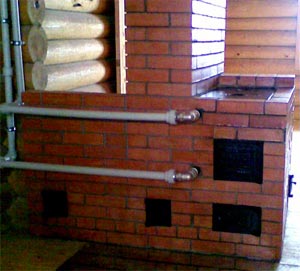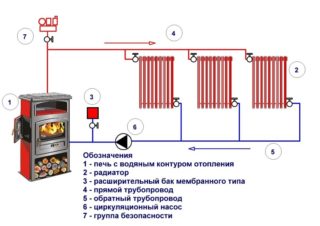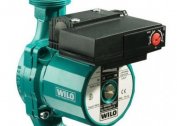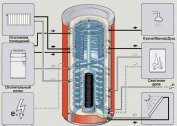Stove heating in private homes is a traditional way of preserving heat and coziness, proven over the years. In places where there is no gas main nearby, people heat rooms with the help of stoves. They are also often used as an auxiliary or backup heat source.
Types of stoves for the home
There are several varieties of stove heating according to the heating method:
- With water circuit. A characteristic feature is that a heat exchanger connected to water heating is installed in the firebox of the furnace. The house will be heated thanks to the surface of the stove, as well as radiators, which are installed in all rooms. This approach allows you to heat houses with a large area, their efficiency is 20-30% higher than that of other varieties.
- Without water heating - a traditional option. The room is heated due to the design of the furnace as a result of convection of air and thermal radiation. They make equipment of different sizes and shapes, but to heat rooms with a large area, you need to install several such furnaces, which is costly and inconvenient.
According to the material of manufacture of the furnace are brick and metal.
The latter take up less space, warm up faster, but cool just as quickly. The case is made of cast iron or steel. To increase the heat transfer time, they are often lined externally or internally with refractory material.
Brick structures are larger in size, but they are more inert - they warm up longer and give off heat longer. In addition, brick kilns can have various sizes and shapes. An additional advantage - they can be disassembled, and then, using the same material, folded in another place.
By the duration of the burning of the structure there are:
- prolonged burning;
- periodic or short burning.
By functional features:
- fireplace stoves;
- heating and cooking;
- heating.
Each modification has advantages and disadvantages. You must familiarize yourself with them before choosing a model.
Air heating
 The stove for heating is very popular due to the economical use of it - the acceptable cost of coal, fuel briquettes or firewood.
The stove for heating is very popular due to the economical use of it - the acceptable cost of coal, fuel briquettes or firewood.
The main disadvantage is the limited heating space, which can be eliminated thanks to the air or water system based on brickwork.
Features of the functioning of heating using an air system are the transfer of a warm air stream to a boiler or heat exchanger. Warm air enters the room through air ducts or directly. Thanks to the small “path”, he does not have time to cool down, so that a uniform and optimal temperature is reached in the house.
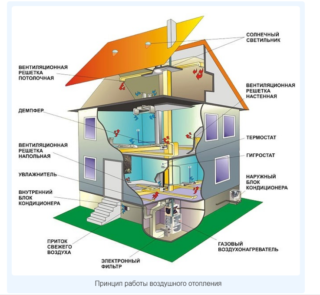 The natural circulation of cold and hot air flows occurs due to the difference in their density. Cold air, penetrating the heating chamber, displaces hot air into the ducts.
The natural circulation of cold and hot air flows occurs due to the difference in their density. Cold air, penetrating the heating chamber, displaces hot air into the ducts.
This method does not require electricity, but if the movement is not fast enough, problems can occur due to overheating of the camera.
Advantages of air heating in comparison with water:
- no need to install radiators, which saves space and finances;
- trouble-free;
- high efficiency.
The device circuit with forced movement allows you to do without additional construction of the duct system.
Furnace-based water heating device
If the house has more than three rooms and all of them need to be heated, it is better to give preference to a brick stove with water heating. This design is additionally equipped with a circuit where water will be heated, from where it flows through pipes to radiators.
For wiring, it is preferable to use pipes made of plastic or polypropylene.
The contours have a different structure, but everyone has one task - to heat the liquid. To accelerate the movement of water, an additional water pump is installed. As the water heats up in the system, pressure increases. So that it does not fail, a membrane tank is connected to the circuit. It controls surges in water pressure in pipes: excess water penetrates into the tank when it rises, and when it cools, it returns to the system again.
When designing and installing a heating system, one of the main tasks is to choose the right heat exchanger. If the wall thickness of the metal pipes is less than 5 mm, they will quickly wear out.
Chimneys
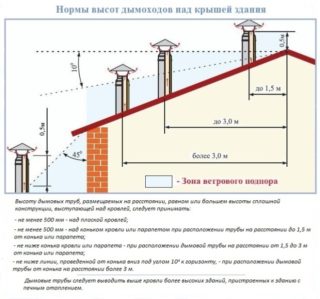 Stove heating is necessarily equipped with chimneys. Their height should be at least 5 meters, starting from the grate. The cross section of such a pipe depends on the amount of flue gas in the furnace process, and this, in turn, depends on the characteristics of heat transfer, design and type of furnace. For example, if the heat transfer is not very large, then the optimal cross-section is 14 * 14 cm, if the heat transfer indicators exceed 3,000 kcal / h, the cross-section should be at least 14 * 25 cm.
Stove heating is necessarily equipped with chimneys. Their height should be at least 5 meters, starting from the grate. The cross section of such a pipe depends on the amount of flue gas in the furnace process, and this, in turn, depends on the characteristics of heat transfer, design and type of furnace. For example, if the heat transfer is not very large, then the optimal cross-section is 14 * 14 cm, if the heat transfer indicators exceed 3,000 kcal / h, the cross-section should be at least 14 * 25 cm.
In places where chimneys pass through the ceiling, a thickening of the masonry is performed with a gradual inlet. In construction, this approach is called - fluff or cutting.
If a country house has a large area and the owners want to install several stoves, it is forbidden to connect them to one chimney, especially if they are built at different levels. This is due to the fact that with their simultaneous heating there are problems with traction.
In the place where the chimney passes, the protection of the abutment site from the penetration of moisture from the atmosphere is mounted through the roof. Design features and the method of abutment depends on the material from which the roof is made. If we are talking about slate, you can use asbestos cord in combination with galvanized roofing iron or cement mortar. If the roof is made of corrugated board or metal, use special abutment strips. In most cases, a golovinnik or cap is installed over the chimney tip to prevent atmospheric precipitation from entering the chimney. They have various sizes and shapes.
If it is difficult to decide which stove to choose for home heating, it is best to consult a specialist who is knowledgeable in these matters.
